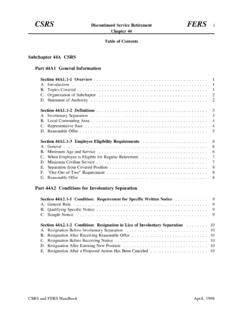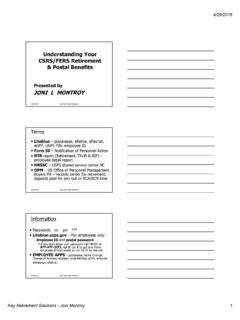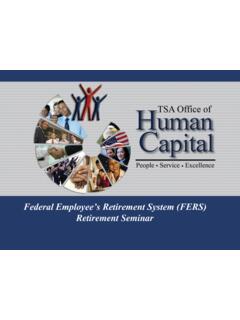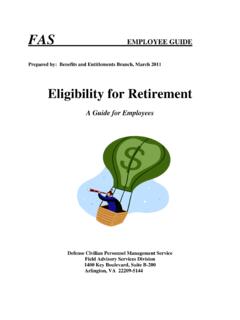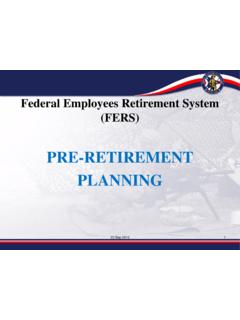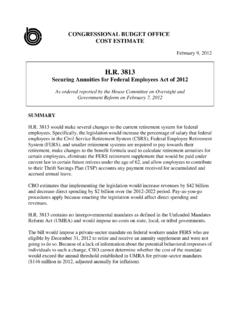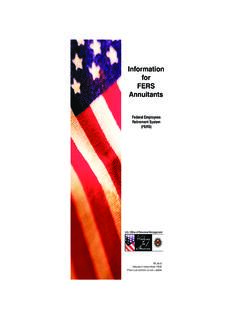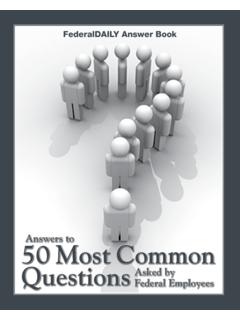Transcription of Federal Employees' Retirement System: Budget and Trust ...
1 Federal Employees Retirement system : Budget and Trust Fund Issues Updated December 13, 2019 Congressional Research Service RL30023 Federal Employees Retirement system : Budget and Trust Fund Issues Congressional Research Service Summary Most of the civilian Federal workforce is covered by one of two Retirement systems: (1) the Civil Service Retirement system (CSRS) for individuals hired before 1984 or (2) the Federal Employees Retirement system ( fers ) for individuals hired in 1984 or later. fers annuities are fully funded by the sum of employee and employer contributions and interest earned by the Treasury bonds held by the Civil Service Retirement and Disability Fund (CSRDF). The Federal government makes supplemental payments into the CSRDF on behalf of employees covered by the CSRS because employee and agency contributions and interest earnings do not meet the full cost of the benefits earned by employees covered by that system .
2 The Office of Management and Budget (OMB), in its FY2020 Budget , estimated that in FY2019, obligations from the CSRDF would total $ billion, of which $ billion will represent annuity payments to retirees and survivors. Other outlays consist of refunds, payments to estates, and administrative expenses. Obligations from the fund are projected to increase by to $ billion in FY2020, of which $ billion will represent annuity payments. OPM estimated that receipts to the CSRDF from all sources would be $ billion in FY2019 and $ billion in FY2020. The year-end balance of the CSRDF was projected to increase from $ billion at the end of FY2018 to $ billion at the end of FY2019. According to the most recent reporting from the Office of Personnel Management, the total annual income of the CSRDF will increase from $ billion in FY2018 to an estimated $ billion in FY2025 and to $ billion in FY2090.
3 The total expenses of the fund are projected to rise more slowly, increasing from $ billion in FY2018 to an estimated $ billion in FY2025 and to $ billion in FY2090. Consequently, the assets held by the CSRDF also are projected to increase steadily, rising from $ billion in FY2018 to an estimated $ trillion in FY2025 and $ trillion in FY2090. Expenditures from the CSRDF currently are about 40% as large as Federal expenditures for the salaries and wages paid to Federal employees. Pension expenditures are projected to decline relative to the government s wage and salary expenses, beginning around FY2020. By FY2090, the expenditures of the CSRDF are estimated to be only about 32% as large as the government s expenditures for wage and salary payments to employees. Because CSRS Retirement benefits have never been fully funded by employer and employee contributions, the CSRDF has an unfunded liability.
4 The total unfunded liability of the CSRDF was $ billion in FY2017. According to actuarial estimates, the unfunded liability of the CSRDF has already peaked, will steadily decline, and is projected to be eliminated by FY2085. Actuarial estimates indicate that the unfunded liability of the CSRS does not pose a threat to the solvency of the Trust fund. There is no point over the next 80 years at which the assets of the Civil Service Retirement and Disability Fund are projected to run out. Federal Employees Retirement system : Budget and Trust Fund Issues Congressional Research Service Contents Introduction .. 1 Fundamentals of Pension Plan Financing .. 1 Pre-funding of Pension Benefits in the Private Sector .. 2 Pre-funding of Federal employee Pension Benefits .. 2 Investment of Trust Fund Assets .. 3 Financing Retirement Annuities for Federal Employees .. 4 employee Contributions.
5 4 Employer Contributions .. 5 Operation of the Civil Service Retirement and Disability 6 Civil Service Retirement Fund Financial 6 The Short-Term Picture .. 6 The Long-Term Picture .. 8 The Civil Service Retirement and Disability Fund in the Federal Budget .. 9 Civil Service Retirement : Funding and Accounting Issues .. 11 Accounting for Pension Costs Under CSRS and fers .. 11 Why Are CSRS Revenues Less Than the Present Value of Benefits?.. 12 Accounting Issues Raised by the Way CSRS Benefits Are Financed .. 13 Conclusion .. 15 Tables Table 1. Receipts and Obligations of the Civil Service Retirement Fund, FY2018-FY2020 .. 7 Table 2. Projected Income and Expenses of the Civil Service Retirement Fund (Combined CSRS and fers Systems) .. 9 Contacts Author Information .. 15 Acknowledgments .. 15 Federal Employees Retirement system : Budget and Trust Fund Issues Congressional Research Service 1 Introduction Pensions for civilian Federal employees are provided through two programs, the Civil Service Retirement system (CSRS) and the Federal Employees Retirement system ( fers ).
6 CSRS was authorized by the Civil Service Retirement Act of 1920 ( 66-215) and fers was established by the Federal Employees Retirement system Act of 1986 ( 99-335). Under both CSRS and fers , employees and their employing agencies make contributions to the Civil Service Retirement and Disability Fund (CSRDF), from which pension benefits are paid to retirees and their surviving dependents. Retirement and disability benefits under fers are fully funded by employee and employer contributions and interest earned by the bonds in which the contributions are invested. The cost of the Retirement and disability benefits earned by employees covered by CSRS, on the other hand, are not fully funded by agency and employee contributions and interest income. The Federal government therefore makes supplemental payments each year into the civil service Trust fund on behalf of employees covered by CSRS.
7 Even with these additional payments into the Trust fund, however, CSRS pensions are not fully pre-funded. Prior to 1984, Federal employees did not pay Social Security payroll taxes and did not earn Social Security benefits. The Social Security Amendments of 1983 ( 98-21) mandated Social Security coverage for civilian Federal employees hired on or after January 1, 1984. This change was made in part because the Social Security system needed additional cash contributions to remain solvent. Enrolling Federal workers in both CSRS and Social Security, however, would have resulted in duplication of some benefits and would have required employee contributions equal to more than 13% of workers salaries. Consequently, Congress directed the development of the fers , with Social Security as the cornerstone. The fers is composed of three elements: (1) Social Security, (2) the fers basic Retirement annuity and the fers supplement , and (3) the Thrift Savings Plan (TSP).
8 1 Most permanent Federal employees initially hired on or after January 1, 1984, are enrolled in the fers , as are employees who voluntarily switched from CSRS to fers during open seasons held in 1987 and 1998. Fundamentals of Pension Plan Financing Retirement plans are classified as either defined benefit (DB) plans or defined contribution (DC) plans. In a DB plan, the Retirement benefit typically is based on an employee s salary and years of service. Under Federal law, a DB plan must offer participants the option to take their benefit as a life annuity . A DC plan for example, a 401(k) is much like a savings account maintained by the employer on behalf of each participating employee . The employer or the employee or both contribute to an account, which is invested in assets such as stocks and bonds. In some DC plans, the amount of the employer contribution depends on how much the employee contributes from his or her pay.
9 When the worker retires, he or she receives the balance in the account, which is the sum of all the contributions that have been made plus interest, dividends, and capital gains (or losses). This is usually paid as a lump-sum, but the employee sometimes has the option to receive benefits as a series of fixed payments over a period of years or as an annuity . An important difference between DB plans and DC plans is that the employer bears the financial risk in a DB plan, whereas the employee bears the financial risk in a DC plan. In a DB plan, the employer promises to provide Retirement benefits equal to a certain dollar amount or a specific percentage of the employee s pay. Under Federal law, employers in the private sector are required 1 This report describes the financing of CSRS and the fers basic annuity . The Thrift Savings Plan is described in CRS Report RL30387, Federal Employees Retirement system : The Role of the Thrift Savings Plan.
10 Federal Employees Retirement system : Budget and Trust Fund Issues Congressional Research Service 2 to pre-fund these benefits by setting aside money in a Trust fund, which is typically invested in stocks, bonds, and other assets. The employer is at risk for the full amount of Retirement benefits its employees have earned. If the assets held in the pension fund are worth less than the present value of the benefits that have been accrued under the plan, the employer is required by law to make up this deficit called an unfunded liability through additional contributions over a period of years. In a DC plan, it is the employee who bears several types of risk, including the risk that markets will decline (market risk), the risk that specific investments he or she chooses will fall in value (investment risk), and the risk that the employee may outlive their Retirement assets (longevity risk).










